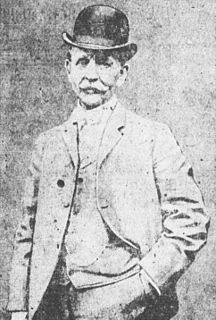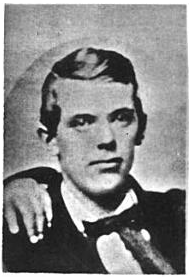Joe Erich was an American criminal fence and early underworld figure in New York City during the 1850s and 1860s. Based from Manhattan's Maiden Lane, Erich associated with many criminals and burglars of the era including Jack Spratt, Jack Adams, Tom Gordon, Tom Kelley, Jim Brady, Bowlegged Moore, Johnny Miller, Jim Painter, Amos Leeds, Bill Smith, Dick Collard, Jack Cooper and others.
William "Mush" Riley was an American businessman, saloonkeeper and underworld figure in Manhattan, New York during the late 19th century. The owner of a Centre Street dive, he was a longtime Five Points personality and associated with many noted criminals of the era. Riley was said to have acquired his name for his fondness of eating corn meal mush dipped in hot brandy. His saloon was located near other Five Points characters such as English-born pickpocket Tommy Taylor, bare-knuckle boxer Jack McManus and Boiled Oysters Malloy, who owned the popular basement resort known as The Ruins just a few doors from Riley's place.

Sophie Lyons was an American criminal and one of the country's most notorious female thieves, pickpockets, shoplifters, and confidence women during the mid-to-late 19th century. She and her husbands Ned Lyons and Billy Burke were among the most sought-after career criminals in the U.S. and Canada, being wanted in several major cities including Philadelphia, Boston, and Montreal from the 1860s until the turn of the 20th century.
Annie Walsh, known under the pseudonym Battle Annie, was an American criminal and member of the Gopher Gang. A well-known criminal figure described in the press as "The Queen of Hell's Kitchen" and "the most feared brick hurler of her time", she was the founder and longtime leader of the gang's female auxiliary, the Lady Gophers, headquartered at Mallet Murphy's Battle Row saloon where they were officially known as the Battle Row Ladies' Social and Athletic Club. She was able to assemble a force from 50 up to several hundred women who, armed with clubs, were used as reserve members in gang fights against rival gangs and police. Walsh and her group were also hired out by businesses and labor unions throughout a number of violent labor disputes during the 1870s. She appears as a minor character in the 2003 historical novel A Passionate Girl by Thomas J. Fleming.
John Daly was an American sportsman, professional gambler and underworld figure in New York during the late 19th century. A protégé of John Morrissey, he was involved in illegal gambling on Broadway and in Midtown Manhattan for over thirty years. He was also among the principal rivals of "Honest" John Kelly up until the turn of the 20th century and was considered one of the most successful and wealthiest gamblers in New York at the time of his death.
Captain Isaiah Rynders was an American businessman, sportsman, underworld figure and political organizer for Tammany Hall. Founder of the Empire Club, a powerful political organization in New York during the mid-19th century, his "sluggers" committed voter intimidation and election fraud on behalf of Tammany Hall throughout the 1840s and 1850s before Tammany became an exclusively Irish-dominated institution.
The Bowe Brothers were a criminal family in New York City during the early-to-mid-19th century. The gang was headed by Martin Bowe, owner of the Catherine Slip sailors' home Glass House, and included Jack, Jim and Bill Bowe. All were well-known shooters, cutters and thieves in New York's Fourth Ward and often led waterfront thugs in raids on dockyards and ships anchored in the East River. The brothers were also fences and disposed of money obtained by other waterfront gangs.

Theodore Allen, or known simply as The Allen, was an American gambler, political organizer, saloon keeper and head of a criminal family in New York City during the mid-to late 19th century. Born to a devout and prominent Methodist family, he and four of his brothers were notorious underworld figures; Wesley, Martin and William Allen were professional burglars while the fourth brother, John Allen, ran an illegal gambling den.
Hester Jane Haskins or Jane the Grabber was an American madam, procuress, and underworld figure in New York City during the 1860s and 1870s. The main rival of Red Light Lizzie, she owned and operated several "houses of ill fame" as well being a chief supplier of prostitutes to bordellos, brothels, and similar establishments throughout the city. She employed a small group of "respectable-looking men and women", numbering a dozen or so, who traveled New England luring young women with promises of exciting jobs back in New York. Once these women arrived, they were abducted and forced to work in her or her clients' establishments.
Ephraim Snow or Old Snow was an American criminal fence and underworld figure on New York City during the early-to mid-19th century. He was one of the first major fences in New York and the main competitor of Joe Erich during the 1850s and 60s, however the two had a far more friendly and cooperative relationship then the fierce rivalries of later fences such as John D. "Traveling Mike" Grady and Fredericka "Marm" Mandelbaum. He operated from a small dry goods store on the corner of Grand and Allen Streets, only a short distance from Erich's establishment in Maiden Lane, and was well known as a dealer in "stolen property of every description". According to underworld lore, Erich once disposed of a flock of sheep that some Bowery thugs brought back with them while on vacation in Upstate New York having stolen them from a farm in Westchester County and herded them "through the streets of the city to the shop of the fence".

Rosanna Peers (?-1840) was an American criminal fence and underworld figure in New York City during the early-to mid 19th century. She is the earliest known business owner to begin actively dealing with the city's emerging underworld and whose Centre Street grocery store and dive bar, established in 1825 just south of Anthony Street, was used as the longtime headquarters of the Forty Thieves upon their formation by Edward Coleman in 1826.
Tom Flaherty, more commonly known under his pseudonym Old Flaherty, was an American criminal, sneak thief and river pirate in New York City during the mid-to late 19th century. He was the patriarch of a criminal family in New York's Seventh Ward which terrorized the New York waterfront in the post-American Civil War era. Flaherty was described as having "long white whiskers and a benevolent smile, but he was one of the most cruel thugs of the Seventh Ward".
The Hole-in-the-Wall was a popular saloon and underworld hangout in what is now the South Street Seaport, Manhattan, New York City during the early- to mid-19th century. It has been described as the "most notorious" saloon in New York city during the 19th century. It was one of many dive bars and similar establishments in New York's infamous Fourth Ward, located at the corner of Water and Dover Streets. The saloon was owned by "One Armed" Charley Monell and featured notorious female criminals Kate Flannery and Gallus Mag as bouncers. Both women were employed by Monell as lieutenants in his local criminal organization, which included shanghaiing, and the latter woman supposedly kept a collection of human ears which she had bitten off from unruly customers in bar brawls. She displayed these as trophies on the bar in pickle jars. Sadie the Goat, the later leader of the Charlton Street Gang, was of the many victims who lost her ear in a brawl with Gallus Mag.
Frank Stephenson was an American saloon keeper and underworld figure in New York City during the mid-to late 19th century. He was the owner of The Black and Tan, a popular Bowery basement bar located on Bleecker Street. It was one of the first saloons to cater to African-Americans and was a competitor against neighboring establishments such as Harry Hill's gambling resort and Billy McGlory's Armory Hall among others. He is also credited for opening the city's first and oldest "undisguised" gay bar, The Slide, also on Bleecker Street.
Red Light Lizzie was the pseudonym of an American madam, procuress and underworld figure in New York City during the mid-to late 19th century. She was known as the most infamous of the city's procurers and controlled much of its prostitution along with Jane the Grabber during the 1860s and 70s. Like her rival, Lizzie employed a number of men and women to travel to rural communities in Upstate New York and New England to lure young girls to the city with promises of well-paying jobs. Some men were paid by Lizzie to bring girls into dive bars and, similar to Shanghaiing, would be given drugged alcohol. The victims would then be forced into prostitution, either by working in her brothels, or being "sold" to similar establishments. Both she and Jane the Grabber specialized in procuring women from wealthy families. She, in fact, owned at least twelve such "houses of ill-repute" and was so successful as a procurer that she sent a monthly circular letter to all of her clients.

William O'Brien, better known as Billy Porter but also known by the alias William or Billy Morton, was an American burglar and underworld figure in New York City during the mid-to late 19th century. He and partner Johnny Irving were longtime members of the Dutch Mob along with Little Freddie and Michael "Sheeny Mike" Kurtz. He was present during the 1883 gunfight at Shang Draper's saloon in which Irving was shot and killed by rival John "Johnny the Mick" Walsh. O'Brien then killed Walsh and was himself gunned down by Shang Draper. Although surviving his wounds, he was tried for, and acquitted of, Walsh's death.

Michael "Pugsey" Hurley, also known by the aliases Pugsey Reilly or Hanley, was an English-born American burglar, river pirate and underworld figure in New York City during the mid-to late 19th century. An old time thief from the old Seventh Ward, he was also a well-known waterfront thug whose criminal career lasted over two decades. He especially gained notoriety as a member of the Patsy Conroy Gang and was a principal figure in many of their most infamous crimes.

"Little" Annie Reilly (1844-unknown), also known under the aliases Kate Cooley, Connelly and Manning, was a 19th-century American thief and con artist widely regarded as "the cleverest woman in her line in America". A well-known member of New York's underworld, she was part of an elite "inner circle" of female career criminals under Marm Mandelbaum during the 1860s and 1870s. These included some of the most notorious thieves, blackmailers and confidence women in the country such as Lena Kleinschmidt, Sophie Lyons, Kid Glove Rosey, Queen Liz, Big Mary and Old Mother Hubbard,

Samuel "Worcester Sam" Perris was a 19th-century French-Canadian burglar, safe cracker and bank robber. An underworld figure in New York City and throughout the northeastern United States during the post-American Civil War era, he was called "one of the most notorious criminals in America".
The Atlantic Guards were a 19th-century American street gang active in New York City from the 1840s to the 1860s. It was one of the original, and among the most important gangs of the early days of the Bowery, along with the Bowery Boys, American Guards, O'Connell Guards, and the True Blue Americans.








